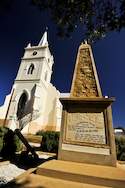Karoo Houses

Lying on the northern foothills of the Swartberg range, Prince Albert is a picturesque farming village with an old-world charm.
It is renowned for its variety of well-preserved architectural styles, and for its 'Prince Albert gables', which date from 1840-60.
This unique gable features the outlines of the 'holbol' gable with a narrow pediment, while horizontal mouldings connect the outlines of the gables.
Other building styles include Karoo houses, with their symmetrical façades and flat roofs, as well as Victorian and Georgian-style buildings.
Also of interest is the historic water mill built in the 1850s. It is the only remaining one of five built in the Prince Albert area during the 19th century.
The Fransie Pienaar Museum depicts the natural and cultural history of the area, and has an interesting display on the brief but frantic gold rush, which took place following the discovery of alluvial gold in the area in 1890.
Fransie Pienaar Museum
The Fransie Pienaar museum building was once, between 1954 and 1982, Prince Albert’s hospital, where many Prince Albert residents were born. The museum displays include many privately collected photos and artefacts, which were largely collected by Fransie Pienaar, however, the collection is still growing, via donations from past and present inhabitants of Prince Albert.
Exhibits on display include the building of the Swartberg Pass, a haunting display on the forced removals and the fossil room. This privately-owned, painstakingly catalogued collection includes a 3 000 million year old piece of petrified algae and a 250 million year old skull.
Fransie Pienaar was another of those women that the isolated farming towns of South Africa seem to produce. Like Helen Martin with her Owl House in Nieu-Bethesda and Ruth Lock in Queenstown with her shells, Fransie Pienaar pursued her personal vision with dedicated single-mindedness. She was a born collector and from her youth set about ensuring that not all of our past would slip from recent memory.
 On the other side of the Swartberg Pass is the picture-perfect town of Prince Albert, situated at the Southern edge of the Great Karoo plain...
On the other side of the Swartberg Pass is the picture-perfect town of Prince Albert, situated at the Southern edge of the Great Karoo plain... Included within the Swartberg Nature Reserve are the Meiringspoort and Gamkapoort Nature Reserves. There are few facilities throughout this ...
Included within the Swartberg Nature Reserve are the Meiringspoort and Gamkapoort Nature Reserves. There are few facilities throughout this ...